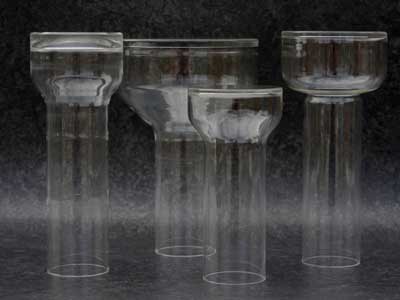Here at Moore’s Glassworks, we specialise in a select set of products that can be used throughout various fields, from medical to military and beyond.
We manufacture products ranging from glass condom moulds and cathode ray tubes to vacuum viewports and more.
One of the products we produce are photomultiplier envelopes.
But what is this? And how is it used?
Let’s take a look.
What is a Photomultiplier?
A photomultiplier is a type of detector that is used to detect and measure light.
There are several components to this tool, including a vaccum tube that contains a photocathode (this is used to convert light into electrons), a series of charged electrodes called dynodes (these help to emit further electrons), and an anode (the negative electrode which supplies electrons).
To put it simply, a photocathode is used to convert light into an electric signal.
When light is shone on a photoacthode, it emits electons, and these are then pushed towards the first dynode along a wave of high voltage electricity.
As the electrons and the dynode collide, even more electrons are produced. This is called secondary emission. This process is repeated again and again, until what you have left is a huge collection of electrons that have passed through many different dynodes.
This is the key part when it comes to amplifying the original signal.
With this abundance of electrons, an electric signal can be produced that is much stronger than the original light that was shone on the photomultiplier.
This piece of equipment is sensitive to very low levels of light, making them perfect in many different settings.
Where are Photomultipliers Used?
Photomultipliers can be used across many settings, including:
Medical – Photomultipliers are regularly found in such equipment as PET scanners.
Physics – You will often find photomultipliers in particle detectors. This is because they are ideal for detecting and measuring lifht emitted by subatomic particles. A famous example is the Large Hadron Collider. They can also be used in nuclear physics to measure the light emitted by radioactive materials.
Astronomy – Celestial objects such as stars are another thing that can be measures by photomultipliers, and you may often find them inside telescopes and similar equipment.
Environmental – Much like when looking up at the stars, a photomultiplier can be used to look down into the ocean and measure the luminescent organisms at the bottom of the sea.
There are many more settings in which these tools can be used to great effect.
But where does a photomultiplier envelope fit into all of this?
Let’s find out.
What is a Photomultiplier Envelope?
One of the key components of a photomultiplier tube not mentioned above is an envelope.
This is a sealed glass enclosure that holds some of the key components, such as the photocathode.
Not only that, but the envelope holds many of the dynodes as well, which are vital for the production of electrons.
In a nutshell, the photomultiplier envelope is the component that holds all of the key parts together. This is why making sure it is manufactured properly is vital, as a lot of work goes on inside these small pieces of glass.
How are Photomultiplier Envelopes Manufactured?
To create these tools, we use glassblowing.
This has been a process for manufacturing glass for centuries, and is our skilled glassblowers and auto-lathes are highly adept at performing.
Depending on the size and specifications, and quantity of objects desired, the manufacturing process may alter slightly, but here is a general run through of what often takes place.
- We select the perfect sized glass tube for the job. This is either a tube already made or one that we mould into shape to make sure it is always the perfect fit.
- Using a flame, we heat one end of the tube. This helps is to shape this part of the envelope. This end will later become the window through which light enters the envelope.
- Once the glass mould is complete, we then can hand the perfect sized glass component over to you for the next steps of the process.
- The inside of the tube is coated with a material that will act as the photocathode.
- Dynodes are applied to the inside of the envelope.
- Once all components are inside, the envelope is sealed. This is again done by the process of heating up the glass and melting it until it is completely shut and sealed.
After the envelope is manufactured, it is typically assembled with other components, such as the anode, and the entire photomultiplier tube is then tested and calibrated to ensure that it meets the required performance specifications.
Your photomultiplier envelope is now ready to go.
Photomultiplier Envelopes from Moore’s Glassworks
Every product from Moore’s Glassworks has been manufactured with quality in mind.
We use expert precision and high levels of quality control to ensure that everything we produce is always the best product it can be. From being the perfect length right down to the nearest mm, to being strong and durable enough to last long-term, no matter what use you have for your glass equipment.
Envelopes for photomultipliers are manufactured in many different configurations.
We offer a wide range of sizes, going from something as small as 19mm in diameter, to something on a much bigger scale, such as our 125mm items.
Our window materials also offer a wide range, with an option to usePyrex, Schott 8250, ultra-violet transmitting Schott 8337, quartz and magnesium fluoride. End windows can be plano-plano, piano-concave or domed and may be round, hexagonal or square.
If you want to know more about what we can offer, our manufacturing process, or have any questions related to our photomultiplier envelopes, then get in touch with our team today.


Leave a Reply